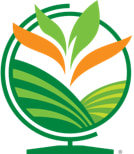What is Flower Farming?
As we are currently in the wonderful season of Spring, many flowers are blooming! And while they are beautiful and fun, a lot goes into making them grow! We got to interview with a former and a current Young Farmers & Ranchers committee chair member to learn more about their experience with floriculture.
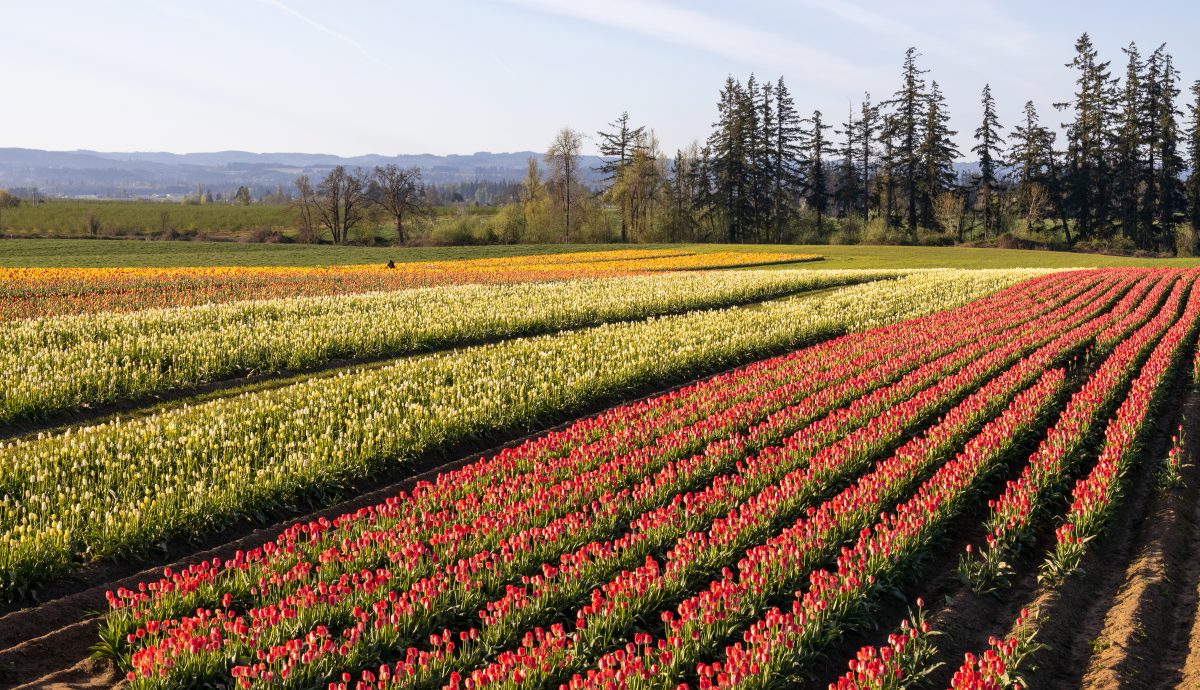
Meet Flower Farmers, Jon Iverson of Wooden Shoe Tulip Farm in Woodburn, Oregon, and Heather Bonanno-Baker of Pleasant Valley Gardens in Methuen, Massachusetts.
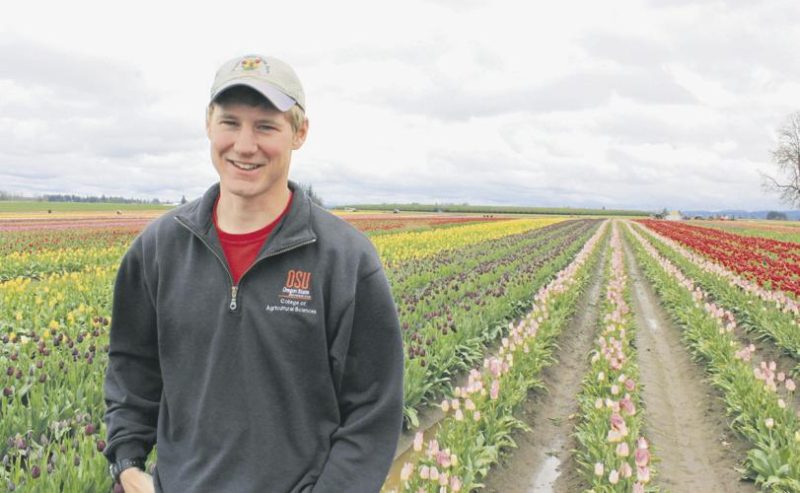
Jon Iverson in the Tulip field at his family farm.
Jon Iverson is a 3rd generation farmer from Woodburn, Oregon. He oversees the flowers and crops at Wooden Shoe Tulip Farm by assessing their health for diseases and viruses and he assists with other jobs around the farm.
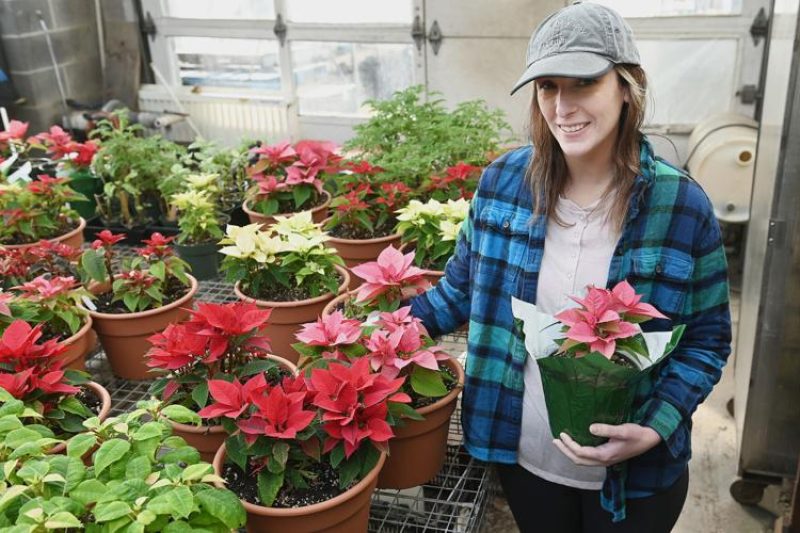
Heather Bonanno-Baker in a greenhouse holding poinsettias at her family farm.
Heather Baker is a 5th generation farmer from Essex County, Massachusetts. She graduated from Stockbridge School of Agriculture with a Sustainable Food and Farming degree in 2013 and took over her family farm in 2016. She grows wholesale tulips and mums and produces them for their farm stand and CSA. She also has an acre of greenhouses where she grows bedding plants, perennials, and vegetable plants for her garden center.
Define Flower Farming or what Flower Farming is for you.
Jon –
For us, flower farming is more of a family experience, getting people to come to a farm that normally wouldn’t. Almost like any other crop… we’re growing flowers for people to come to see and take pictures of.
Heather –
Flower farming is the cultivation of flowering and ornamental plants for gardens or the floral industry.
How did you become a Flower Farmer? Why?
Jon –
The family started growing flowers in the '70s, initially focusing on bulb production for a client in Ohio. They discovered a technique called "forcing a bulb," which involves making it bloom at an unconventional time. Realizing the potential in Oregon's bulb growth, we began working together to cultivate bulbs, harvest them, and subject them to a chilling period in a cooler. By transferring them to a greenhouse, the client could have cut flowers ready for Christmas. This approach wasn't possible with Holland bulbs, and thus our flower farming journey began. After the client retired, the family purchased the bulb stock from him. Initially, our focus was mainly on bulb production, selling to gardeners, wholesalers, and retail stores. Over time, we expanded into cut flower production, creating bouquets sold in grocery stores and flower shops. Eventually, we transitioned into agritourism.
Heather –
I was born into flower farming. My Great-Great Grandfather established our farm in 1910. Although we didn't start growing flowers until the late '80s-early '90s, it became my entire upbringing. Initially, I didn't perceive the farm as something extraordinary; it was simply my way of life. However, during my college years, where I initially pursued Civil Engineering, I realized that I loved my farm and wanted to return to it. Consequently, I obtained a degree in Sustainable Food and Farming.
What types of flowers do you farm?
Jon –
We farm tulips and daffodils. We also grow other crops, especially when it’s a slower season for tulips, like in the wintertime.
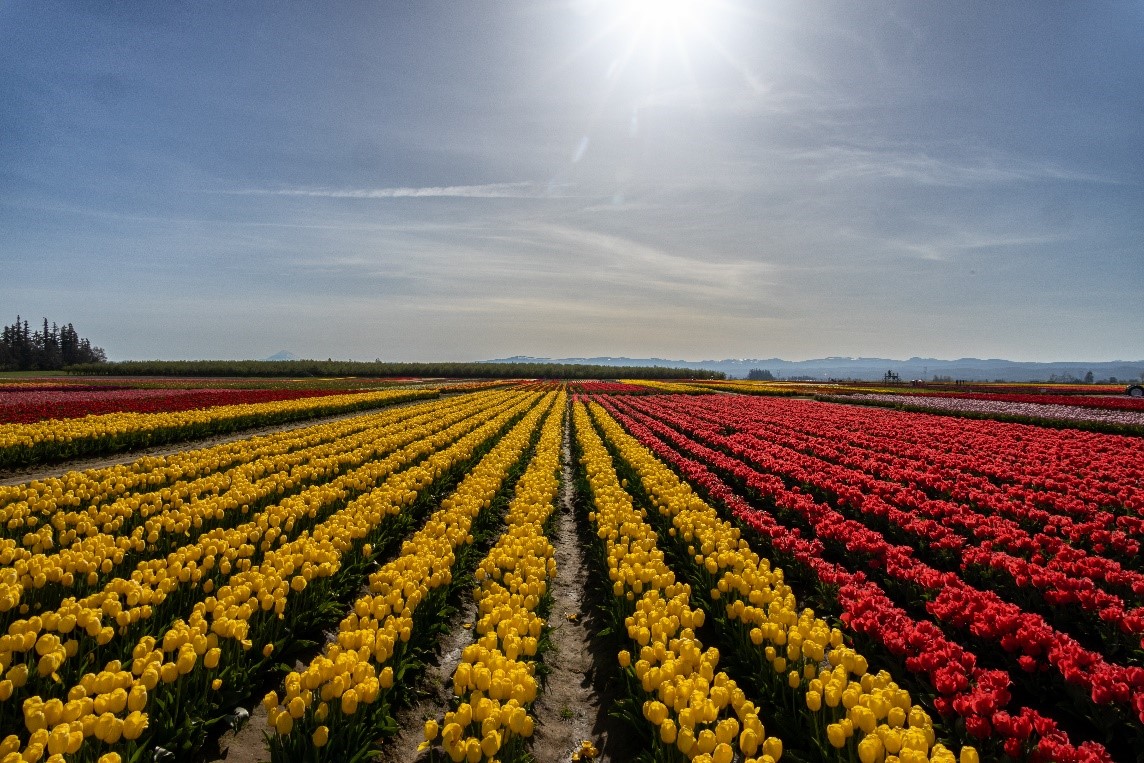
A variety of tulips at Wooden Shoe Farm.
Heather –
I grow 10,000 potted tulips and 110,000 potted mums wholesale. For our garden center, we grow a large selection of annual bedding plants, including but not limited to geraniums, petunias, lantanas, impatiens, salvia, pansies, and marigolds. We also grow 5,000 hanging baskets in a number of sizes, patio pots, potted sunflowers, and perennials, and bring in pre-finished shrubs for our garden center as well.
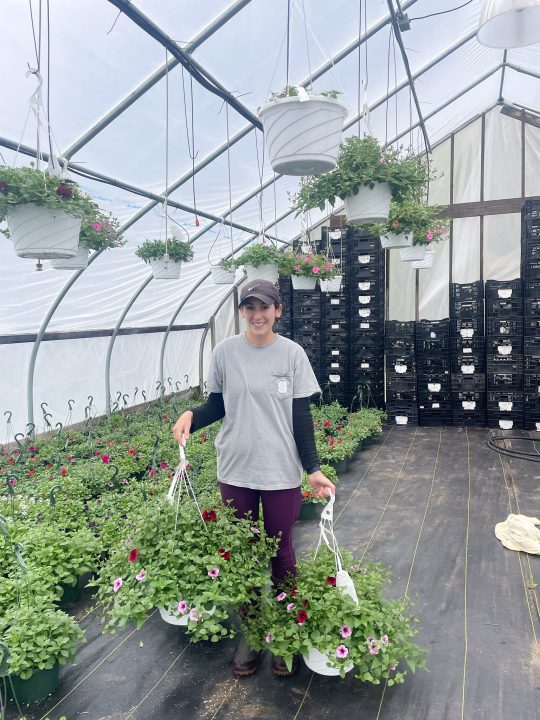
Heather holding two hanging baskets with petunias in them.
Do you grow flowers indoors, outdoors, or both? Why?
Jon –
We used to grow flowers indoors to get them to bloom at a time when they wouldn’t do it naturally – a process called “foreseeing.” We stopped almost 10 years ago and now grow outdoors because it is cheaper, and we have more space for people to come and see the flowers.
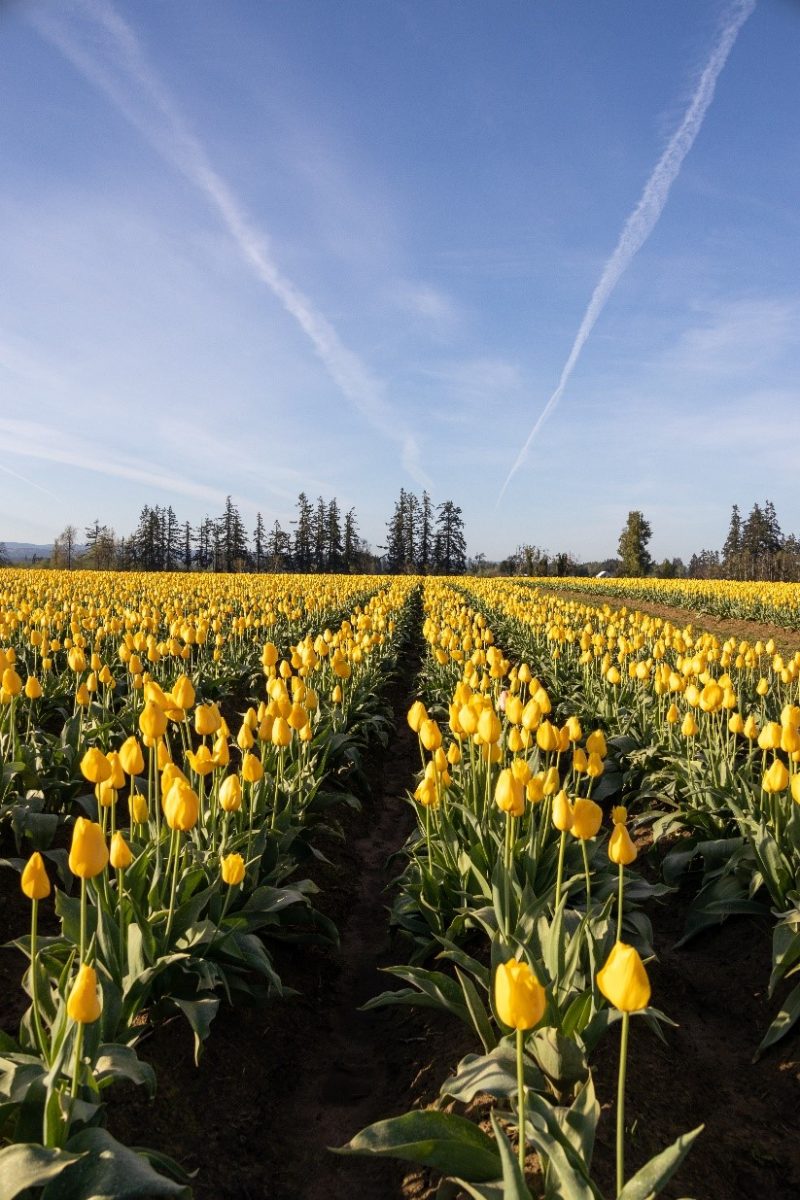
Columns of yellow tulips with space for people to walk through.
Heather –
We grow all our plants for the garden center in one acre of greenhouses. This allows us to start working in February when the New England weather is extremely cold. Growing indoors also grants us greater control over environmental conditions. Tulip bulbs are planted in October and placed into cold storage. About six weeks before Easter, we transfer them to our greenhouse, where we regulate the temperature to achieve the desired stage for selling: showing color but still completely closed. The bulbs require darkness and cold to develop roots, appearing like tiny spikes when removed from storage. Additionally, we have approximately seven acres dedicated to growing mums in our field. Mums thrive with cool nights, making outdoor cultivation the optimal choice for us.
What role do you play in Flower Farming? / What is your job?
Jon –
There are many jobs that we work on together, but my primary role is often referred to as the 'doctor.' I am responsible for ensuring the health of the flowers. Therefore, I examine them to detect diseases and pests and determine the specific nutrition requirements for the tulips to ensure they grow into the best possible crop.
Heather –
I am the greenhouse and field manager on our farm. I am responsible for ordering the plugs and seeds, seeding all the trays, and managing the employees to pot and grow the flowers. Additionally, I create flower combinations for our hanging baskets and patio planters. I oversee the greenhouse temperatures, especially in February when Massachusetts experiences freezing temperatures. I have an app on my phone that alerts me if the temperature drops too low or rises too high. Therefore, I don't sleep well on extremely cold nights!
What skills do you need to be successful in doing your job?
Jon –
A significant part of it involves having knowledge about plants. I need to be able to examine a tulip and determine whether it is sick, identify the cause of the illness, or assess if it appears healthy. Many of these skills revolve around understanding common diseases affecting tulips, recognizing signs of nutritional deficiencies in flowers, knowing which fertilizers to apply, and understanding which chemicals to use for specific problem-solving purposes.
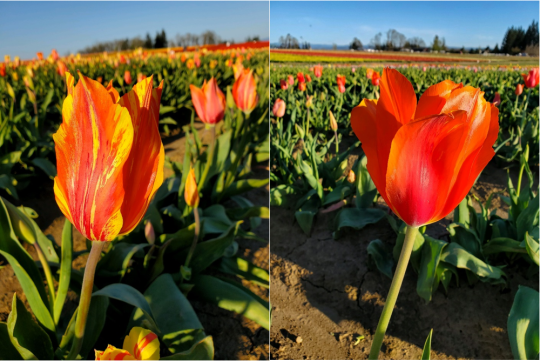
Temple of Beauty flower with and without a virus outbreak.
Heather –
I believe that having a basic knowledge of various flower types is crucial, particularly understanding their sunlight preferences (i.e., sun or shade), knowing the duration it takes for them to grow from seed to flowering, understanding the appropriate watering requirements for different types, and being proficient in seeding and planting techniques. Additionally, a vital skill is the ability to identify common pests and diseases affecting flowers. Being able to detect and address these issues early on is essential in preventing them from becoming major problems.

A fun photo of Heather and her dog in the Greenhouse.
What is your favorite part about doing your job?
Jon –
The festival is my favorite part of the job. It's the culmination of all the hard work, where a flower blooms, and we can share it with visitors to the farm. Seeing the fields through someone else's eyes is always exciting because, as I work with it daily, I can become desensitized to the remarkable sight. However, when newcomers visit the farm for the first time and have that "wow" reaction, it reminds me of what makes our farm special. Sharing that experience with them is truly my favorite thing.
Heather –
My favorite part of my job is simply observing everything grow from tiny seedlings to stunning flowers. It's especially rewarding when I'm away for a few days and return, as I can truly witness the remarkable transformation that has occurred in such a short span of time. It provides a tremendous sense of accomplishment.
FUN FACT!
What is one fun fact about flower farming that you would like to share that many people may not know?
Jon –
One unique aspect of our tulip cultivation is the utilization of long nets for planting. We adopted this Dutch technology approximately 20 years ago for a couple of reasons. Firstly, it significantly expedites our harvest process as we can simply lift the nets containing all the bulbs instead of digging them up and separating them from the soil. Secondly, this method reduces the number of flowers left behind. We follow a 4-year rotation with the tulips, meaning they will be planted in the same field for the next 4 years. This approach helps control disease. By using nets, we minimize the number of bulbs left behind, which can otherwise contribute to disease issues. For instance, in the previous year's field, I noticed some tulips emerging among other crops. These tulips, called "volunteers," sprouted spontaneously without intentional planting. However, they often serve as a source of disease. Planting in nets aids in preventing this concern.
Heather –
Growing flowers requires a significant amount of time. Achieving their beauty demands extensive knowledge and unwavering dedication. It's a gratifying experience when customers appreciate our hard work and acknowledge the health and beauty of our flowers. Moreover, it's a visually stunning job—being surrounded by flowers all day is truly a delightful experience!
GET CONNECTED!
Jon Iverson
- Website – https://www.woodenshoe.com/
- Facebook – Wooden Shoe Tulip Farm
- Instagram – @woodenshoefarm
Heather Bonanno-Baker
- Website – www.pleasantvalleygardens.com
- Facebook – Pleasant Valley Gardens: The Bonanno Family Farm
- Instagram – @pleasant_valley_gardens

